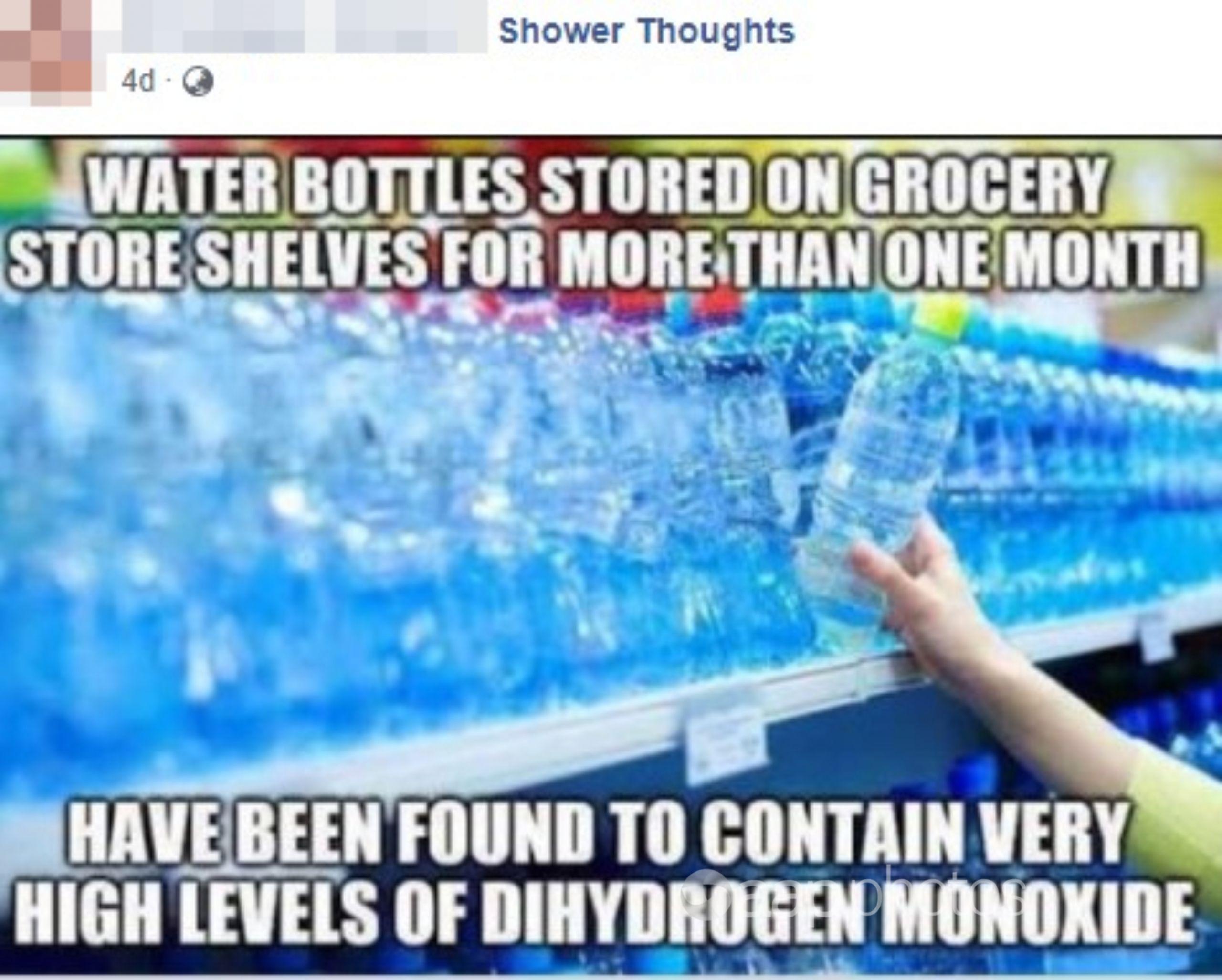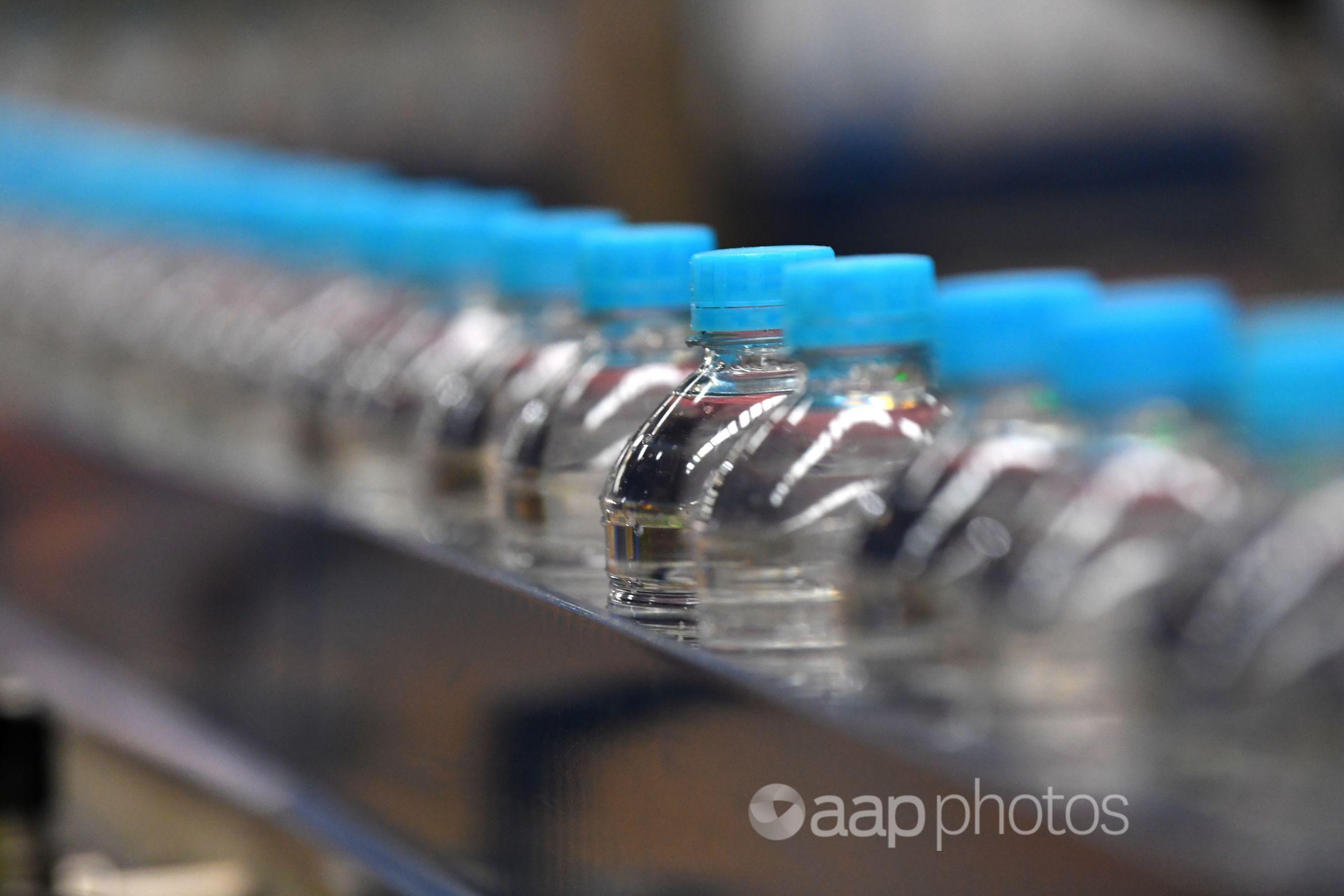The Statement
A Facebook post claims high levels of “dihydrogen monoxide” have been found in bottled water left lingering on supermarket shelves.
The January 30 post, from a user in New Zealand, features an image of rows of water in plastic bottles in a store.
A caption written over the image reads: “WATER BOTTLES STORED ON GROCERY STORE SHELVES FOR MORE THAN ONE MONTH … HAVE BEEN FOUND TO CONTAIN VERY HIGH LEVELS OF DIHYDROGEN MONOXIDE.”
At the time of writing, the post had been shared more than 55 times and attracted more than 95 comments and 25,000 views.

The Analysis
Bottled water is a big global industry, worth hundreds of billions of dollars in sales each year. But the drinks industry isn’t covering up a sinister secret about its products containing dangerous levels of a possibly toxic chemical.
The term “dihydrogen monoxide” literally means “two hydrogen, one oxygen” and it is one of several little-known descriptors for water, which has the chemical formula H2O. Other chemical names for water include oxidane and dihydrogen oxide.
The Facebook post is a variation on the decades-old dihydrogen monoxide parody, which is so persistent that DHMO now has its own website and Wikipedia page. Related hoaxes often involve calls for the ominous-sounding chemical to be banned or regulated, linking it to dire events like drowning deaths and acid rain.
In 1999, fact-checking website Snopes debunked a claim that ‘”dihydrogen monoxide is a dangerous chemical that should be banned”. It noted the hoax showed “even the most innocuous of substances can be made to sound like a dangerous threat to human life”.
The parody reportedly dates back to as early as 1983, when an April Fool’s Day edition of Michigan’s Durand Express newspaper is said to have warned residents that dihydrogen monoxide had been found in the city’s water pipes. The hoax was reportedly repeated in 1990 at the University of California, where two students publicised the dangers of DHMO.
In 1997, a 14-year-old student in Idaho gave 50 of his fellow students a report titled “Dihydrogen Monoxide: The Unrecognised Killer” for his school science fair project, according to the Washington Post.
The report accurately laid out the dangers of DHMO, including that it had been linked to the deaths of thousands of Americans through accidental ingestion, while in gas form it could cause serious burns.
On the back of the report, 43 of the group – or 86 per cent of respondents – voted to ban the compound due to its deadly nature. The student was reported to have won the grand prize at the regional science fair for his project, titled: “How Gullible Are We?”
In 2004, city officials in Aliso Viejo were left red-faced after a staff report to the local council highlighted the dangers posed by the chemical, which was said to “threaten human health and safety”.
New Zealand National Party MP Jacqui Dean was caught out by the hoax in 2007 after an online blogger asked for her help in banning dihydrogen monoxide, the Oamaru Herald reported.
A letter, signed by Mrs Dean, was sent to associate health minister Jim Anderton, asking if the government’s Expert Advisory Committee on Drugs had a view on banning the “drug”.
Mr Anderton responded to Mrs Dean’s letter, saying: “Thank you for your letter of 23 August, 2007 about your constituent call for the ban on dihydrogen monoxide, (but) dihydrogen monoxide is water.
“It may have been described to you as colourless, odourless, tasteless and causing the death of uncounted thousands of people every year … (but) I had to respond that the experts had no intention of (banning water).”
Mrs Dean was not the only Kiwi to call for a ban on DHMO. In 2001, a staff member in Green MP Sue Kedgley’s office responded to a request to back the campaign against DHMO by saying Ms Kedgley would “be absolutely supportive of the campaign to back this toxic substance”, the New Zealand Press Association reported.
In 2016, Waikato Regional Council was forced to reassure locals that a chemical spill warning circulating on social media about dihydrogen monoxide was a hoax. The warning said hundreds of thousands of litres of DHMO had drained into the Waikato River and it could be fatal if breathed into the lungs, a Radio New Zealand (RNZ) article said.
The warning was reportedly shared hundreds of times by locals, with some commenters becoming angry and calling for a quick clean-up and huge fines.

The Verdict
The post’s claim that water bottles stored on grocery store shelves for more than one month have been found to contain very high levels of dihydrogen monoxide is satirical. It is the latest in a long series of jokes and hoaxes that play on an alternative chemical name for water.
Satire – The content uses irony, exaggeration, or absurdity for criticism or awareness, particularly in the context of political, religious, or social issues, but a reasonable user would not immediately understand it to be satirical.
AAP FactCheck is an accredited member of the International Fact-Checking Network. If you would like to support our independent, fact-based journalism, you can make a contribution to AAP here.
All information, text and images included on the AAP Websites is for personal use only and may not be re-written, copied, re-sold or re-distributed, framed, linked, shared onto social media or otherwise used whether for compensation of any kind or not, unless you have the prior written permission of AAP. For more information, please refer to our standard terms and conditions.

















